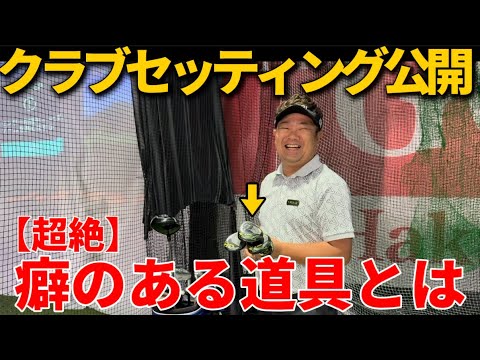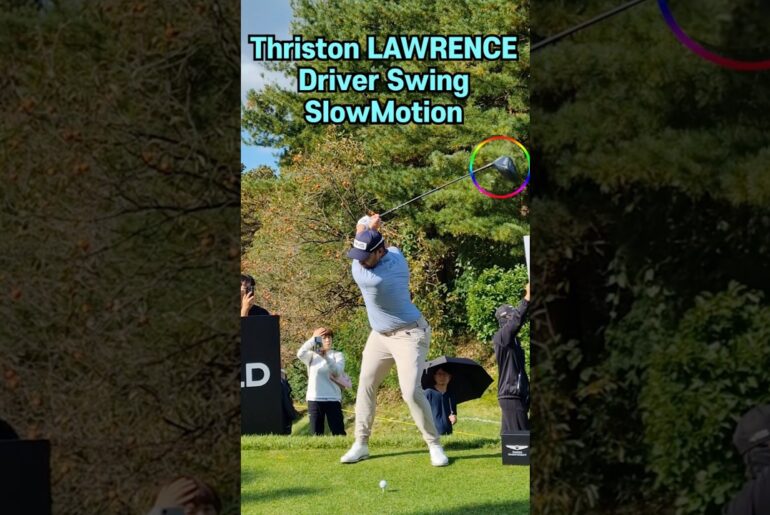Cameron Young’s WITB from his win at the 2025 Wyndham Championship. Cameron is a Titleist staff player but his bag is definitely filled with some unique clubs. Here are the clubs he used to secure his first PGA Tour win!
https://www.golfwrx.com/764218/cameron-youngs-winning-witb-2025-wyndham-championship/
Driver: Titleist GT2 (9 degrees, A1 SureFit setting)
Shaft: Mitsubishi Tensei 1K Pro Orange 70 TX
3-wood: Titleist GT3 (15 degrees)
Shaft: Mitsubishi Tensei 1K White 80 TX
Hybrid: Titleist GT2 (21 degrees)
Shaft: Fujikura Ventus HB Black VeloCore+ 10 X
Irons: Titleist T200 (4), Titleist T100 (5), Titleist 631.CY Prototype (6-9)
Shafts: True Temper Dynamic Gold X7 (4-9)
Wedges: Titleist Vokey Design SM10 (48-10F, 52-12F, 56-14F @57), WedgeWorks (60-K* @62)
Shafts: True Temper Dynamic Gold X7
Putter: Scotty Cameron Phantom 9.5 Tour Prototype
Grips: Golf Pride Tour Velvet Cord
Ball: Titleist Pro V1x Prototype
Hey, welcome back to Golf the VX’s winning what’s in the bag where this week we are taking a look at Cameron Young’s bag from the 2025 Windom Championship. Uh I unfortunately didn’t get to watch the tournament at all. I was actually in a golf weekend uh with some buddies, so unfortunately didn’t get to watch it, but a huge congratulations to Cameron Young on the win. Now Cameron is a titleless staffer and his bag is fully titleless, but he’s got some cool unique things in there uh that I think are definitely worth taking a look at. It’s not just the same old. Uh so I’m pretty excited to jump into his bag. I think he’s got a really awesome setup. And as we jump in, we always do we start at the top, which is Driver. And Driver is the Titalist GT2. So, this is the slightly more forgiving, a little bit higher launching, a little bit more spinny head uh compared to say the GT3. Now, there’s also a GT1 and a GT4. Uh but the two is kind of like the most widespread. It kind of fits the wide uh range of widest range of golfers. But the nice thing, too, is that GT2 and GT3 from a dress look almost identical. It’s very hard to distinguish which one is which. So, even if you don’t need the low lower spinning, more penetrating FL of the GT3, but you love that look, the sound, the feel, you get into the GT2 and you’re going to get pretty much all of that. So, it may sound slightly different, uh, but the look is going to be the same. So, you don’t have to like, you know, sit there and say, “Man, I really, you know, need this performance, but I really like the look of that other driver.” They both have that same look, which is really awesome. Now, this is a 90° head, and he is playing the Hoszle, the Surfeit Huzzle in A1. Uh, now the photo on here shows a Huzzle in D1. That was a previous photo from I believe the RBC Canadian uh where we took a photo he has since changed over to A1. We kind of confirmed that with titalist and A1 means it is the stated loft 90° standard lie angle all that. So standard 90° head with the GT2 and it is shafted up with a Mitsubishi Tensei 1K Pro Orange 70TX. So the Pro Orange is the counterbalanced low launch low spin shaft. And counterbalance basically means that if you were to put it on a scale, the handle tends to weigh a little bit more than the tip. It’s more balanced towards the handle. Uh and this is done for a few reasons. One, people like that feel. Uh two, you’re building a longer club, so you uh as you get longer, the head feels heavier. So as you build a longer club, a counterbalance sha shaft will make it feel a little bit closer to normal. Uh or the third way is you’re building a head that’s just heavier. There’s some people out there who uh like the fat like the feel and the idea of putting more mass in the head will translate into more ball speed. it’s going to drive through the ball a little bit more uh with added mass. So, a counterbalance shaft will let you build kind of a standard length driver uh with that heavier head with no problem. But, uh it’s a great shaft. It has kind of a carbon kevlar weave in it for ball speed. Uh and it of course has that 1K fiber uh wrap for added stability without adding much weight. Uh now, this one here comes in, even though it’s a 70TX, it comes in at 80 g uncut. So, the full uh 46 in shaft is 80 grams. when you cut it down, you’re going to lose a few grams on, you know, if you’re going to tip it or take some off the butt end. Uh, but 80 g is the uncut weight, and it is 2.7° of torque. Uh, now on there, he’s got a little sticker for 45 in. Uh, assuming I think he still plays it at 45 in in length. Then we move into 3-wood, and his 3-wood is a Titus GT3, uh, 15 degree. Now, Titles doesn’t put 3-wood, 5, anything like that. Uh, they just put the degrees on there, but the 15° is considered a 3-wood. Uh now this one here has that movable sole plate uh where it has the uh the weight you can shift forward and back. Uh now on that wear and you can kind of dial in if you want a little more fade bias, more draw bias or the gear effect as you swing it will also kind of feel different if you shift that shift that weight out of the toe or into the heel. Uh it’s going to add a kind of a different feel as you swing the club. Now this one here is uh and it’s set to neutral on that sole weight for Cameron Young. Now this one here is also set to A1 on the huzzle setting. So it’s going 15° standard lie angle. Nothing kind of change there. Shaft on this one is going to be a Mitsubishi Tensei, but it is going to be the 1K Pro White. So this is going to be the low launch, low launch, low spin shaft, but it is not counterbalanced. It’s traditional in terms of its weighting. And when you look at the profile on it, it’s kind of a medium stiffness handle, a little stiffer midsection, and then a medium uh stiffness tip section. So real firm in the middle, a little softer at both ends, still low launch, low spin, very stable. Uh, and it is basically also has that 1K fiber in uh, across it for a little bit added stability. The tip section on the 1K Pro White does have some boron strands that run through it. Uh, and that adds uh, a little bit of stability while also holding a little bit of compression. Like carbon doesn’t, I guess, compress very well. Boron can help with that compression in there and add some uh, solid feel to the shaft. Now, this one comes in at 86 g and 2.7° of torque because it is an 80TX. I don’t remember if I said that on there uh, but the 80 g version. So, 86 g, 2.7 degrees of torque for his 3-wood shaft. From his 3-wood, he then moves into a hybrid. And this is again a Titalist. And it is the GT2 uh the 21 degree hybrid. So, uh I believe this is uh you know, a 21 degree. Again, they don’t put numbers on them. Uh and hybrids kind of have their own little range of what one place considers a three, another place considers a four. Uh but this is the 21 degree GT2 head. Uh now this one here is actually surprisingly for the shape. Uh it is slightly bigger than the GT3 one, but it’s actually got a fairly good shape to it. Uh a good size. It is the most stable hybrid in the Titus lineup. Partly because it has two weights, one in the heel, one in the toe that just spread that mass out, making it an extremely stable head. So if you do miss it a little bit, uh the bolt tends to go pretty straight. Now the hoszle on this one, the SH fit nozzle set to A1. So standard 21 uh degrees of loft, standard lie angle. Uh he does have a 5 g weight in the toe uh of the sole and a 7 g weight in the heel. So it is set up just slightly draw bias but pretty darn neutral. Uh and that head does not have like a ton of left in it. You can even set it up with big heavy weight in the toe if you’re worried about it. Now the shaft on this one is the Fujikura Ventus HB black uh 10X. And this is the new one, the the one with Voicore Plus, the one that just came out earlier in the year. Uh and the Voicore Plus is basically a slightly uh modified bias core. So, the original Ventus VO core was a bias core that was this material that added stability to the shaft and then they added the the carbon wraps on top of it that would kind of change the profile and other things. This bias core here is updated with some new material uh to make it even more stable while still keeping ball speed high. Now, the 10X1 uh is definitely pretty heavy. Comes in at 106 g, 2° of torque. It is a really stiff, low launch, low spin, low spin hybrid/utility iron shaft. Uh, it’s got a very stiff handle section, a a still pretty darn stiff midsection, and a very stiff tip. So, overall, really stiff, really stable, low launch, and low spin. Now, we move into his iron set, and it’s definitely something that’s a little bit more unique. Uh, he’s definitely has a combo set, uh, but it’s probably not one you’ve ever seen. The first iron is going to be a 4 iron, and that is a Titleist T200. So, this is going to be the multi-piece, uh, kind of players distance iron that Titles has made. This is the previous gen, not the brand new one that just came out. Uh this is the previous one uh that came out in 2023. Uh so it does have that kind of silver badge on the back. The new ones don’t have that. Uh but it is basically a body uh that is made from steel, a bunch of internal weighting and then a really fast face put on it. So it’s got some added ball speed, a little bit more launch, and that can help gapping at the top end of the bag or hitting a number uh whether it’s height or distance, whatever that Cameron wants to hit. So a little bit of speed, little bit of extra height, all that built into his forearm. Uh, and this one is shafted up with a True Temper Dynamic Gold X7. So, we have never I don’t know if we’ve ever talked about X7 yet before on here, but the X7 is a pretty unique shaft. It is the stiffest, lowest launching, lowest spinning shaft that True Temper makes. Uh, it is extremely stiff, even compared to the Dynamic Gold X100. This is basically the next step up. So, 133 g, low launch, low spin, really stiff handle section. Uh but yes, a very stable and stiff sha shaft for really big hitters, fast, high ball speed players or high swing speed players. Uh this shaft is built for them. Kind of got made famous years ago with I think Jason Day played it for a long time. Uh and then I think has since moved uh but again heavy, stiff, low launch and low spin. The next iron in his bag is his 5iron, which is a Titleist T100. Uh now this again is the previous gen, the 2023 model. uh not the brand new uh T series that just hit the market. Uh but this one, you know, again, smaller player CB, uh it’s forged, it does have two internal tungsten weights in the toe and the heel. So, while it is tiny, has a thin top line, not a ton of offset, all that. Uh it’s still actually pretty stable and it’s very forgiving, good feel to it, probably one of the most played players irons out on tour. Uh and I assume the new one will kind of take over and do that as well. But this one, uh was in the bag for a ton of Tour pros out there. And this one is also shafted up with a true temper dynamic gold S7 or X7. Uh and you know this thing again 133 grams low launch low spin. It does have a slightly bigger hu handle diameter. So like a standard X100 is a 600 uh in terms of uh a diameter in the butt section of the shaft. This one’s a 610. Typically as you go bigger it adds a little stability, a little stiffness to the shaft. So, uh, you will have that being the slight difference, uh, you know, just in terms of the the size of the shafts. The handle section on the X7 is just a little bit bigger there. Then we move into the rest of his irons, 6 through9 iron, and these are titleless 631cy prototypes. Yes, these are, of course, prototypes. These are built for Cameron Young. These are irons. Uh, they’re muscleback forge muscleback blades. Uh, so in theory, when you first see them, you might just think it’s like a 620 MB. it is a iron design strictly for him. Uh so the 631 and then the CY of course Cameron Young being at the end of it. Uh and the big thing with these is that they have a slightly different CG placement. Uh it’s a little bit lower on these blades compared to some others. So it does have a little higher flight uh that Cameron likes as well as it’s got a sole that has a pre-worn leading edge and it’s a little bit wider. So turf interaction was a big thing for Cameron along with the big uh the added height. Both those things are designed into this iron. So uh he’s been said before this iron is perfect. He has no uh plans of ever changing exact exactly what he wants. But higher ball foot and then that pre-worn leading edge will help as that club enters the ground. It will kind of reduce some of the digging. Want to get that uh that iron through there shallower as well as the wider sole will reduce some of the digging and that pre-worn worn leading edge will also get that leading edge down a little bit in order on tight lies to get that contact up on the face near the center where it needs to be. So a totally custom designed set of blades for Cameron Young. Uh, I think they came to him at some point and said, you know, what would you like to see from a set of irons? Uh, and then they came to him and just built them. And he now has his own set of, uh, prototype blades, which is pretty darn cool. So, uh, he placed the those 6 through9 and just like the other irons, he’s playing the True Temper Dynamic Gold X7s, uh, in those sha in those irons as well as the shaft. So, again, really stiff, low launching, low spinning uh, shafts there for those iron that iron set. We move to wedges. and wedges. He’s got uh basically four wedges. Uh the first one’s going to be the uh the pitching wedge replacement, which is going to be a Titalist Devoki SM10. This is going to be the 4810.10 F grind. So, full soul uh 48°. So, we’re going to assume his irons are bas basically playing off a little bit weaker spec. Uh I don’t have the exact specs. Title title doesn’t necessarily hand out all that information sometimes. Uh but this is a 48.10F. So, pitching wedge replacement. Uh that is basically some people play the sand wedge version instead of the set pitching wedge. And some for some people it’s a shape thing. They like a certain shape. For other people it’s a launch and spin thing. Uh a sand wedge kind of matching uh wedge will will spin and launch a little bit differently than an iron one. And it’s his case since his irons are custom made where they fly a little bit higher. That SM10 may fly a little bit flatter, maybe give them a little bit more control uh while still having spin in the pitching wedge there. And that F grind is of course that full sole. uh not a ton of relief or anything like that to it. A little bit wider. Great turf interaction on full shots. Then you move into his gap wedge and his gap wedge is a 52.12F. So again, I think uh you know there’s kind of a trend here with Cameron Young that he you know turf interaction. He might get a little bit steep, might take a little bigger diffit and these you know slightly wider more uh soles with more bounce tend to help him with that turf interaction. So 52.12F again this is the higher bounce version of the gap wedge. They make a low balance version as well or lower call it standard bounce version uh in the same sole grind. Then we move to a 56 degree and it’s 56. I bet you guessed it is a 56.14 f grind. So again more bounce. Uh it’s it’s funny. I think we always thought tour players played super low bounce wedges. They could kind of manipulate them and play all the shots they wanted to play. It seems like the trend has definitely been higher bounce with a lot of players. Uh I know Sheffller, a few others have been playing the same 56.14F. Uh but high bounce, great out of the bunker, tons of float. They play usually play in kind of softer sand. Uh but this thing here, great for full shots. Uh it’s not going to dig. It’s just going to get kind of hit the turf uh and glide through. Now, he does play this one degree weak, so it’s even really playing like a 15F. Uh but a lot of bounce, reduced digging. It’s going to play really well. And for these guys, I mean, they can still manipulate the face, open it, and that leading edge coming up off the ground isn’t going to change a whole lot for them. So, 56.14F for the sand wedge bent uh one week to 57. Now for his lob wedge, he is playing the Titalist Voki Wedgeworks 60k star grind. Uh now this is a 60k star, but it is actually bent too weak. So it’s playing 62 and that’s going to add uh a little bit of bounce to it. So it goes from 60° to 8° of bounce. And Cameron has actually said uh that he actually had this wedge. He was playing a T grind before uh but found that out of the bunker he just wasn’t as consistent with it. went to the KStar uh found it to be better and then they benched it a little weak and he found it to be great. It’s perfect. The bunker plays really well and that added bounce just helps him kind of get through the turf. Now, this one does have a pre-worn leading edge and a little bit of trailing edge relief so you can still open the face up, play some higher lofted shots. That leading edge is going to allow you to keep that leading edge low and uh take it off tight lies without having to worry about it catching it low on the face as well. uh and bending uh like it’s bent six to uh to 62 helps add a little loft. You can hit a little bit higher and it’s just overall a really versatile wedge. Now the all three of the or all four of these wedges are shafted up with true temper dynamic gold X7s. Kind of interesting cuz a lot of people move from like say X100 in irons, they go to S400 in wedges. Uh Cameron staying with super stiff, super heavy shafts throughout all the wedges, which just shows you that there is not one way to do it in terms of wedges. Some people like a little bit softer uh and a little bit heavier. Cameron Young likes to stay really stiff and really heavy. Uh these should produce kind of a a more, you know, boring, flatter trajectory. That’ll probably give someone like him more control as he’s playing different shots, flighting it differently uh into the green. So X7s, again, 133 g, so pretty darn heavy. Pretty much uh S400 weight, but even stiffer profile. Now, his putter, this is a pretty interesting one. It is a Scotty Cameron Phantom 9.5R tour prototype. So, he used to play a 9.2, moved to the R, which has the slant neck on it. They call it a jet neck uh over there in the Scotty Cameron world. Uh but it is a short slant neck that typically adds a little bit more towh hang. So, towh hang is uh the face if you just rest the putter uh like on a table or in your hands and let the head just kind of freely rotate. Uh the amount of tow hang is how down the toe points as you let it rest there. And typically the slant neck adds a little bit of toe hang. And what a lot of times this does is it gives kind of a blade feel to a mallet. So you get kind of the stability and the look of a mallet, longer sight lines, things like that. Uh but then you still have that feel through the stroke of a blade because it’s going to that that toe flow is going to want to rotate a certain way depending on how much towh hang it has. So you got to get the best of both worlds. Now this one here, if you look at it from a dress, it actually has a little softer shaping to a retail model. So this is a of course a circle T. It’s a tour prototype. is built for these guys on tour and they Scotty’s crew typically will make things a little bit different if it’s a request of a player. But if you look at the corners, especially at the heel and toe, those edges on the retail model are very sharp. You know, they’re very angled, very sharp. On this model, they’re definitely softened up, more rounded. The putter looks almost a little bit smaller from doing that. Uh and then also that transition where uh those corners go down into the kind of the wings of the putter, those are also a little bit softer. You don’t see as much the milling lines and things like that on it. So overall, just a little bit softer shape, a little more rounded, uh not as edgy with this 9.5R out on tour. His has just a single long sight line on it. I think the retail one has two long lines uh across the top duels. His just has a single one done with black paint fill. And it’s got a little bit more of a kind of a media blasted satin look to it compared to the retail one, which is just a little bit shinier in terms of the kind of brush chromeish. It’s not pure chrome, but it’s a little bit brighter than this duller finish. Now you look on the face and it does have a kind have a deeper milling. This is usually offering a little bit softer feel and sound to it. So you’ll get a little less click and a little bit softer feel as the ball leaves the face because there’s less material in contact with the ball. Now the other interesting thing of this putter is that you look at the shaft. The shaft is a Scotty Cameron experimental shaft. Now this is a shaft we got photos of back in May of 2024. Uh and the photos you know you’ve seen there on YouTube are of that shaft in 2024. This one here looks to be graphite. It’s made by US cuz it says US on it. But the tip section is interesting. So these slant necks usually a shaft has to go there’s a little post on there and the shaft gets epoxied on over it. So you slide the shaft over the post. Well, graphite shafts you can’t do that. There’s not a big enough uh internal diameter to actually slide over a post. So this one here looks like it does have some type of like metal tip or something. The tip looks different. There’s there’s definitely different material there. It’s probably metal that connects then to the graphite upper section of the shaft. So this could be multimaterial. Uh it definitely is a prototype. Um very cool looking and they’ve done it kind of seamlessly. I’ve se seen some shafts like this uh that sometimes look a little bulky uh or like US makes the all-in shaft which is a kind of matte black carbon fiber upper section and then it’s got a steel tip section that’s in chrome. So two different looks. This one here blends a little bit nicer. Uh they’re very similar colors and it does work with this latex. So the graphite shafts uh a lot of times are a little bit stiffer. They have, you know, really low torque ratings. uh and people like the feel of that stiffer uh that stiffer putter shaft in their putter. It could be that uh but there’s no word on what the specs are on that shaft. But a pretty cool piece in this uh prototype putter. And then the grip on it is a Superstroke Zenergy pistol 1.0 in white and black, which is the kind of middle of the range. It’s uh I would say kind of the the closer to small. There’s a GT uh a pistol Tour and then the 1.0 is the next size bigger. So just a little bit bigger but still a little bit on the smaller side. a little bit more traditional pistol shape with that arc near the upper hand. Now, for grips on the rest of his club, he playing the Golf Pride Tour velvet cord. Uh, unfortunately, I’m not really sure what he has in terms of, you know, are they wraps, you know, how many wraps, anything like that. But the cord basically has some cord running through it. It’s an actual like cotton fiber that runs in. Great for moisture management on hot days and things like that. Uh, but it really does add a little bit of traction, a little bit of roughness to the grip. uh that players who either sweat a lot uh or play in kind of humid conditions or wet conditions really like or you just like the really feel of uh of that on the club. So ball is going to be another interesting one. Uh he just switched over to a titleist Prov1X prototype. Uh and if you look on it, it’s a basically it says Prov1X, but there’s two little dots on the lefth hand side. So I guess you’re going to call uh a double left dot Prov1x. Uh this is a prototype that uh Cameron has been working I guess with the the Titus R&D department on Titus is not telling us anything about it in terms of what it does. The only thing we know is that Cameron Young has said uh you know that he’s he’s been a high high spin person and he manages that uh but it doesn’t seem like he hits it high. It likes to hit a high ball. Um so this could be something where it’s even maybe higher launching and lower spinning than the Prov1x Left Dash. Uh it also could be something that spins differently, but it is definitely something that’s a little bit different. based on the Prov1X, it’s going to have some type of character characteristics that that’s different. He also made a comment about uh this ball testing where uh there was a hole where he was kind of in between clubs. You know, 5iron was kind of there, but it was too much. Uh and sixiron, he didn’t think he could get it to the hole. Uh with six iron in the practice round, uh he tried this new ball with the sixiron and he made it hole high. So, uh something that probably flying a little bit easier for him. And again, it could be that lower spin. Uh could be maybe a little higher flight. We are not sure yet. Uh, again, Titalist is is basically admitting that he’s playing a prototype, but not telling us anything about it. So, something to watch going forward if it’s something that maybe they release in limited quantities later on. They’ve done that before with other prototypes uh that we’ve gotten out there. So, we’ll see. Maybe we’ll get a few boxes that show up at your local shop you’ll be able to grab and go out and try. But, for right now, it is a prototype that only you’re getting if you have your tour card. So, but that is it. That is the uh winning what’s in the bag for Cameron Young at the 2025 Windom Championship. So, congratulations to him uh on a great win and check back next week when we’ll jump into the next winner’s what’s in the bag.








7 Comments
1st one 🎉Congrats to Cam!
Double Dot is probably a lower flying left dash.
I wish you would stop using low spin for shafts. Shafts dont create spin. They create launch conditions and create face angles. The head, CG, and swing dynamica are what dictate the spin profile.
saw a lot of the align max grips in his bag this week actually.
If it's a Left Dash that putts softer, I'm very curious.
Cam is a great guy. Saw him at the pebble pro am this year and he wasn’t playing well. But he still signed and threw balls to kids, had fun, and was a true gentlemen even though he wasn’t playing his best. I love to see the full circle coming to victory and I think there isn’t anyone more deserving. Oh. And the left dot…
High launching irons with low launching shafts. Interesting